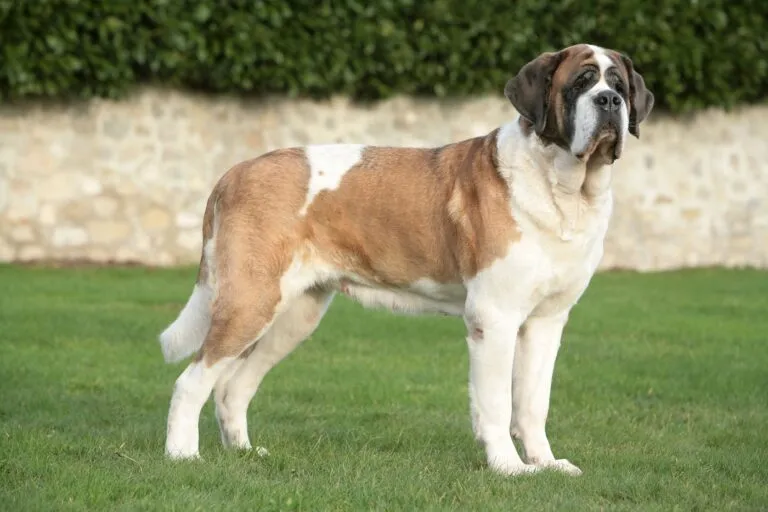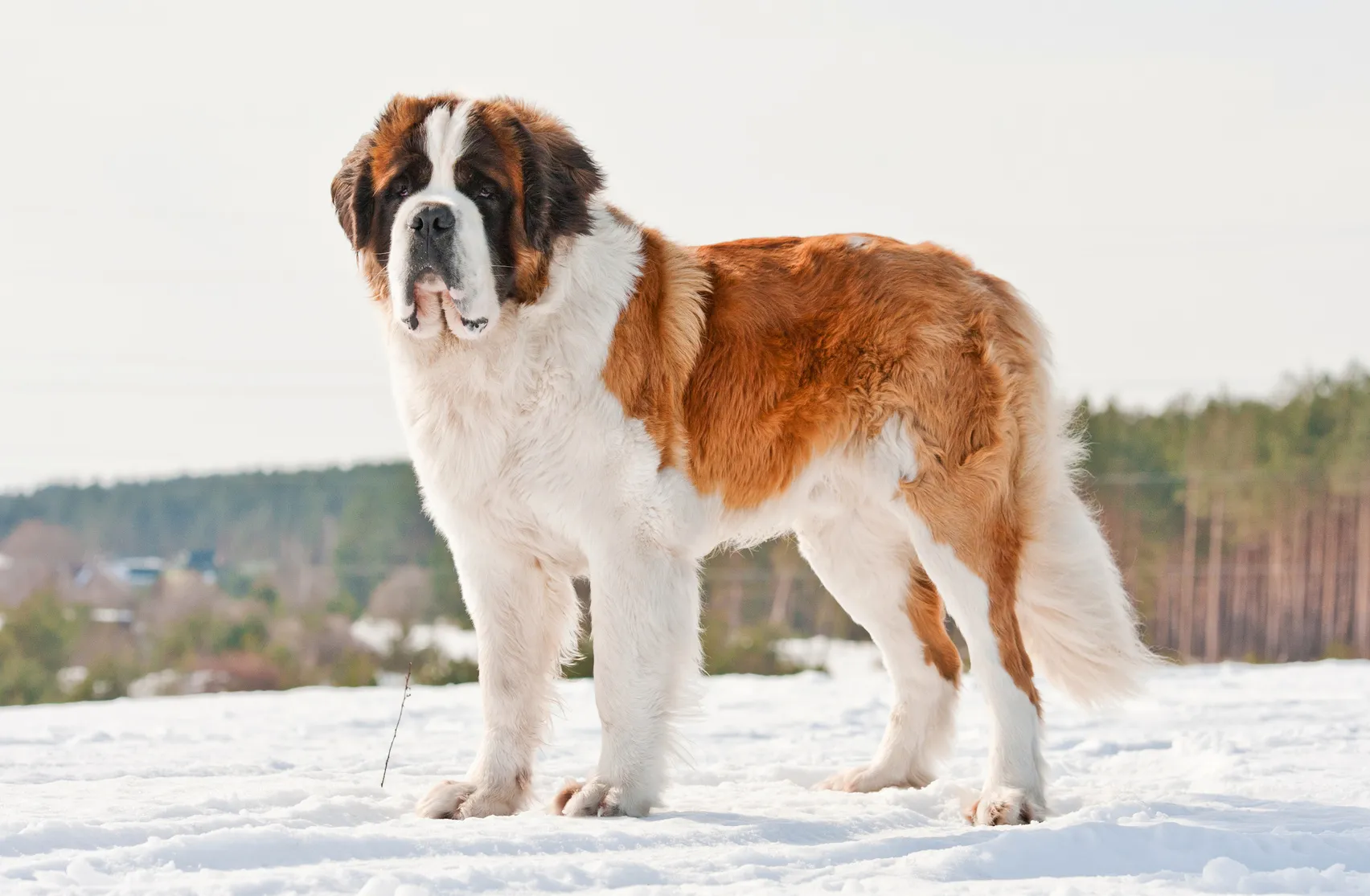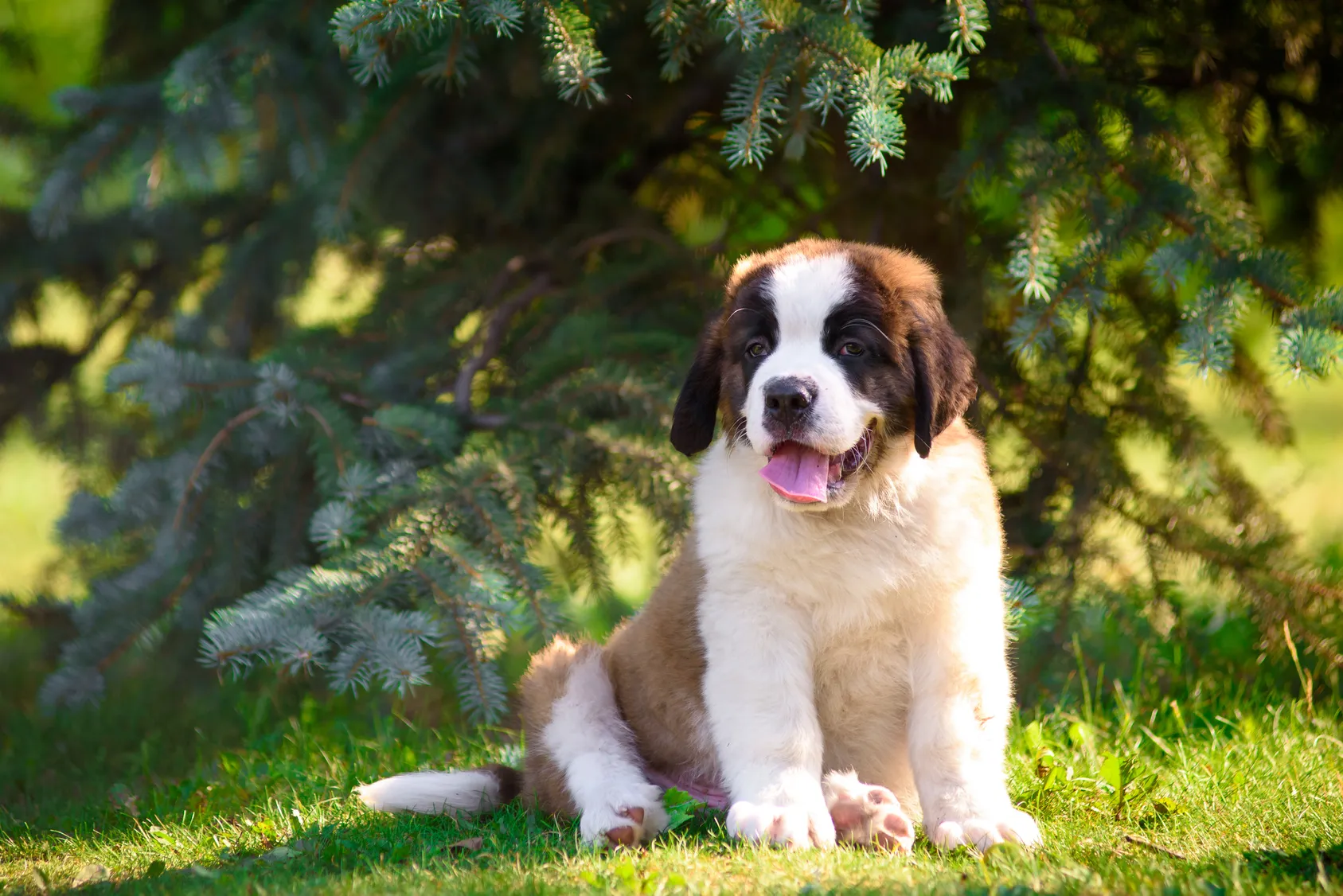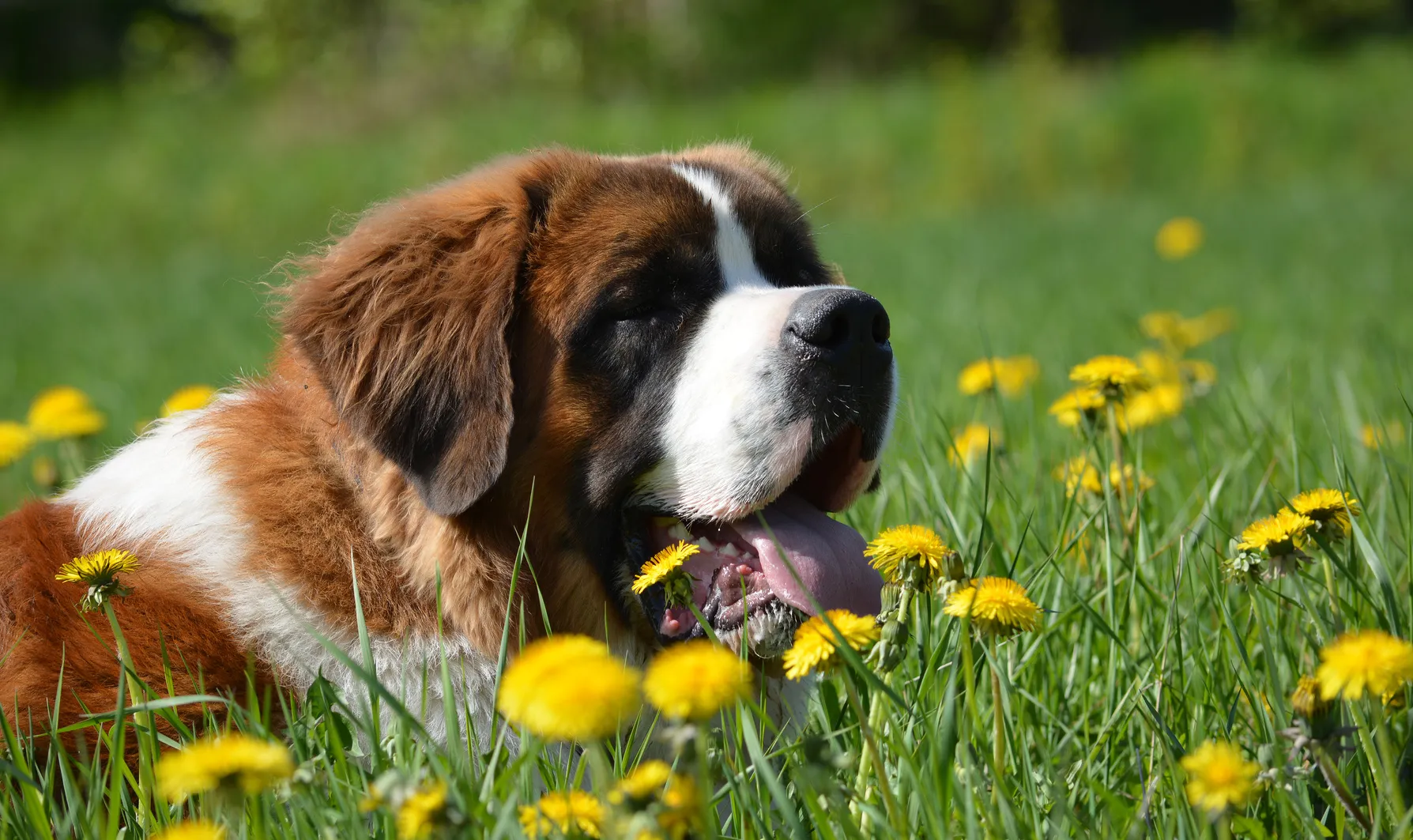Beagle
The Beagle's short legs can be deceiving – this medium-sized dog keeps you on your toes and is always full of surprises! This friendly breed is active, fearless and extremely clever.
The present-day St Bernard no longer has much in common with its renowned ancestor Barry, who saved the lives of over 40 avalanche victims. It is too heavy and bulky to be much use as an avalanche dog. However, these legendary giants have maintained their innate helpfulness, good nature and love of children to this day.

© CALLALLOO CANDCY / stock.adobe.com
The St. Bernard is a gentle giant.
The St Bernard’s heart is as big as its build. Its proverbial good nature and love of children make it a popular family dog that also feels at ease in families with small children despite its size. They are calm, even-tempered dogs and aren’t easily flustered. At the same time though, these gentle giants are very sensitive and need close contact with their human family. Living in a kennel would be torture for these affectionate pedigree dogs. They always act as protective companions to their owner and look to be close to them at all times. Their reliability, watchfulness and moderate protective instinct make them trustworthy watchdogs too. They show almost no aggression, though this isn’t at all necessary in most cases due to their imposing appearance.
You shouldn’t underestimate the immense strength of these dogs when they form part of family life. As playful and cuddly as the St Bernard may be, a well-intended nudge can soon make a small child fall over. In order to steer their boundless strength in the right direction, these large Swiss dogs definitely need consistent training. After all, St Bernards are known for their stubbornness. However, they prove to be incredibly obedient and loyal companions if they are firmly integrated into family life, in which they mainly receive love and affection as well as the necessary consistency.
With males reaching a shoulder height of up to 90cm and up to 80kg in weight, the St Bernard is one of the world’s largest and heaviest dog breeds. Females also make a real impression, reaching up to 80cm in height. The bulky head, strong throat and powerful body lend these pedigree dogs their remarkable appearance, which may be slightly frightening for some – though only until they show their counterpart their gentle nature.
Nowadays, pleasant and tolerant St Bernards are found with both long and short fur, as was the case with the original St Bernard. The fur of long-haired St Bernards is of medium length and lies close and flat to the body. Light waves are permitted. The wider audience prefers the long-haired variety at present. The colour of the fur is white with reddish brown or reddish brown with white in different nuances. White markings on the chest, paws, nose, throat and tip of the tail are explicitly specified in the standard. A white ruff around the neck and symmetrical dark facial mask are the finishing touches for these perfect canine giants.
 © Grigorita Ko / stock.adobe.com
© Grigorita Ko / stock.adobe.com
The history of the St Bernard is closely linked to that of the hospice on the Great St Bernard Pass. Legend has it that the hospice was founded by the Augustine monk Bernhard von Menthon around 980. Mont Joux, as the Great St Bernard was then known, was one of the most important trade and pilgrim trails of the Alps at this time. From the 17th century, monks living there bred these large dogs as guard and rescue dogs. The St Bernard became particularly well-known as an avalanche rescue dog that saved the lives of numerous people. The breed achieved global fame with the now legendary Barry, who lived in the hospice from 1800 to 1812. Barry was said to have saved the lives of 40 people buried by an avalanche. Although the story that Barry woke up a young boy lying in the snow by licking him and getting him to sit on his back so that he could take him to the hospice to save his life hasn’t been proven to this day, it has brought the breed fame across the world.
There is as much uncertainty surrounding the origin of the St Bernard as there is with Barry’s story. Whilst some cynologists consider the ancestors to be Roman Molossoids, which came to the Alpine region with Caesar’s legions, others believe there is a relation to the large Alpine Dog, also known as the Cattle Dog. Others insist that the St Bernard originates from Asia’s Tibetan Mastiff. There is no absolute certainty for any of these theories, though the St Bernard’s close relation to other mastiff-like dog breeds cannot be denied.
What’s certain is that early St Bernards that made a name for themselves as avalanche rescue dogs only bear a distant resemblance to the present-day breed type. Neither the size nor the colours reflect the St Bernard as we know it today. Although long-haired and bulky St Bernards appear very imposing, this development of the breed has made them unsuitable as avalanche rescue dogs, with other breeds having replaced them for this task long ago. Originally more agile with short hair, earlier St Bernards presumably gained mass and their long hair around the middle of the 19th century when Newfoundlands were first paired at the hospice. The monks sold or gave away dogs that had become unsuitable for mountain work to prominent figures, meaning that the imposing St Bernard became a kind of luxury dog over time. Nowadays, Switzerland’s national dog is primarily a family and companion dog rarely still kept as a watchdog.
 © Евгения Шихалеева / stock.adobe.com
© Евгения Шихалеева / stock.adobe.com
Until 2005, these legendary pedigree dogs were bred at the hospice on the Great St Bernard Pass. Nowadays, the association Barry du Grand-St-Bernard continues breeding these Augustine canons. At the middle of the 19th century, pedigree breeding commenced and many fans developed their own St Bernard breed, with the first breeders still focusing on the short-haired hospice type. Heinrich Schumacher, a butcher and landlord from Bollingen in Bern, is considered the founder of the modern St Bernard breed. In 1867, his short-haired dogs Sultan and Favorite won gold medals at a global exhibition in Paris. However, soon afterwards more and more younger breeders chose a bulkier type of St Bernard with longer fur. Schumacher gave up breeding in disillusionment. After all, exhibition attendees and potential buyers preferred the modern type with its heavy angular skull. The original hospice dogs with short hair gradually disappeared from the picture. The Swiss standard, which must be upheld to this day by all breeders belonging to a St Bernard club mandated by the FCI, allows both short and long-haired St Bernards.
St Bernards from reputable breeders are considered healthy and robust dogs resistant to diseases. Although hereditary diseases still emerge, such as hip dysplasia, which primarily affects large dogs, the quantity of diseases has thankfully been reduced thanks to breeding efforts. However, the St Bernard’s life expectancy is mostly less than 10 years. St Bernards are primarily affected by eye problems, salivary cysts, diabetes, stomach twist and bone cancer. In order to avoid such diseases, potential buyers should only purchase puppies from responsible breeders. They can prove the impeccable health of all the animals they deploy for breeding. Since the required examinations, assessments and vaccinations bring significant costs for breeders, it goes without saying that a healthy St Bernard puppy with all necessary paperwork is only available for 1,000 Euros or above.
It’s in the hands of the owner for their young puppy to develop into a healthy and agile adult dog. The choice of food plays a crucial role here. The subject of the right food depends on several factors, like the dog in question’s age, state of health, weight and activity level. There is unfortunately no generic answer regarding the perfect food composition. You should establish a diet plan with the help of your breeder or vet. The food should be balanced in terms of components, i.e. protein, fats and carbohydrates should feature in the right proportions. In addition, your dog needs the right amount of trace elements and vitamins. As a rule of thumb for a balanced diet for dogs of wolverine origin, the food should consist of around 70% meat, 20% vegetables and maximum 10% grain. Whether you choose wet, dry or fresh food depends less on the dog’s taste than that of the owner. After all, a St Bernard owner has to be able to integrate into their daily schedule purchasing or making the vast quantities of food required by such a large dog.
However, please don’t overestimate the amount of food for a St Bernard. Too many of these pedigree dogs are still overweight. For their benefit, it’s better to avoid too many snacks between meals. There shouldn’t be more than two to three meals per day. In order to avoid the dreaded stomach twist, you should make sure too that your dog gets enough rest after meals.
 © Elina I / stock.adobe.com
© Elina I / stock.adobe.com
It goes without saying that a dog as large as the St Bernard can only be kept in a house with a generous garden. Small city apartments are definitely no place for St Bernards. These people-focused giants also need to be very close to their family. Being kept in a kennel for lengthy periods will lead to their mental decline. However, you should bear in mind that St Bernards tend to drool a lot. Patches of saliva on trousers, armchairs and the sofa are part and parcel of life with a St Bernard. In order to protect their joints and muscles, they should avoid regularly climbing stairs or walking on surfaces that are too flat and could cause them to slip. This is particularly important initially during the growth phase, though can be relevant again too in old age.
This is somewhat more time-consuming than training. Regular brushing is essential for long-haired dogs. In addition, the eyes should be the subject of particular attention. This is very important to avoid potential problems and recognise diseases at an early stage.
Heavy St Bernards generally have rather moderate exercise requirements and are quite unsuited to dog sports too. Nevertheless, they do need sufficient outdoor exercise, so long walks with their owner are compulsory. It’s important for St Bernards to get used to their lead from a young age. They should also learn the most important rules of behaviour with loving but consistent training. Otherwise, the stubborn St Bernard may take its owner out for a walk rather than the other way round! Hardly anyone would be able to compete with a power packet like the St Bernard. However, these gentle giants are very obedient and easy to train if they receive consistent training from early on.
For dog lovers with plenty of space, time and not least money (after all, owning such a large dog isn’t cheap), the St Bernard is certainly an unbelievably loyal and friendly companion. It will delight its owners with its exceptional sensitivity and willingness to help.
The Beagle's short legs can be deceiving – this medium-sized dog keeps you on your toes and is always full of surprises! This friendly breed is active, fearless and extremely clever.
The Golden Retriever is still one of the most popular dog breeds, especially with families. It is defined not just by its docility, but shows numerous other qualities too. Read in the following article everything you need to know about the Golden Retriever.
The German Shepherd is one of the most popular utility dog breeds in the world, though the willing-to-learn and people-focused nature of these versatile dogs also makes them suitable for family life.